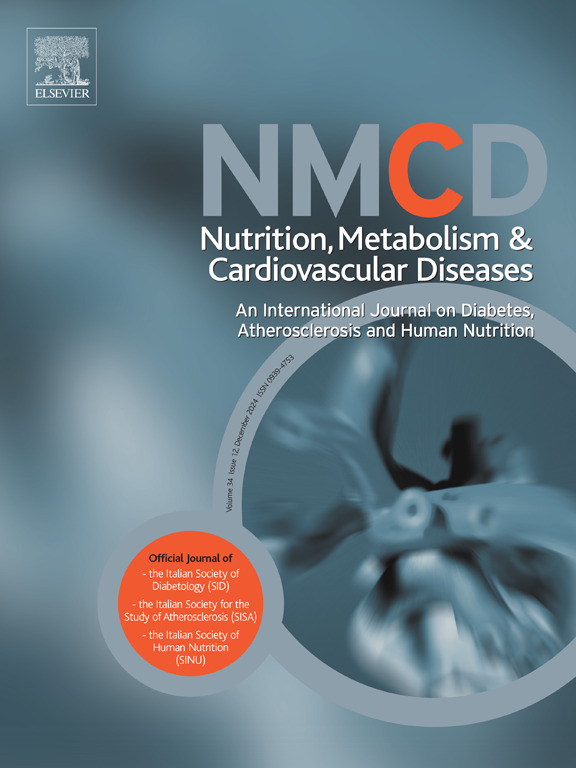Do genetically determined very high and very low LDL levels contribute to Lp(a) plasma concentration?
IF 3.3
3区 医学
Q2 CARDIAC & CARDIOVASCULAR SYSTEMS
Nutrition Metabolism and Cardiovascular Diseases
Pub Date : 2025-02-01
DOI:10.1016/j.numecd.2024.08.016
引用次数: 0
Abstract
Background and aims
Lipoprotein(a) [Lp(a)] is a well-recognized risk factor for atherosclerotic cardiovascular disease (ASCVD). Few data are available on the distribution of Lp(a) levels among subjects at different cardiovascular risk and in subjects with monogenic and polygenic dyslipidemias (familial hypercholesterolemia, FH and familial hypobetalipoproteinemia type 1, FHBL1).
The aim of this study was to investigate the distribution of Lp(a) plasma levels in subjects with high and low LDL-C levels (FH and FHBL1) and in the general population.
Methods and results
The study cohorts included 356 hypercholesterolemic patients, 212 carrying a FH causative mutation, 144 with clinical FH (mutation negative - FHneg), 52 FHBL1 and 797 free-living subjects. Lp(a) levels were significantly higher in FH subjects (both FH and FHneg) (median 12.46 mg/dl and 14.0 mg/dl, respectively) compared with FHBL1 and free-living subjects (7.68 mg/dl and 7.18 mg/dl, respectively). More, Lp(a) levels were similar in FH subjects carrying LDLR defective and null mutations and FHneg. Subjects at high and very high CV risk exhibited significant higher Lp(a) levels (median 10.68 mg/dl and 9.20 mg/dl, respectively) compared with low and moderate CV risk (median 5.72 mg/dl and 7.80 mg/dl, respectively) (p < 0.0008).
Conclusions
FH subjects exhibit higher Lp(a) levels than FHBL1 and general population. Lp(a) slightly contribute to hypercholesterolemia in FH patients. Subjects at high and very high CV risk exhibited significant higher Lp(a) levels compared with low and moderate CV risk. Combined evaluation of Lp(a) levels in FH subjects with other traditional risk factors could identify very high-risk individuals who may benefit from early aggressive treatments to avoid premature CV events.
由基因决定的极高和极低 LDL 水平是否会导致 Lp(a) 血浆浓度升高?
脂蛋白(a)[Lp(a)]是公认的动脉粥样硬化性心血管疾病(ASCVD)的危险因素。关于不同心血管风险的受试者以及单基因和多基因血脂异常(家族性高胆固醇血症、FH 和家族性低脂蛋白血症 1 型、FHBL1)受试者的脂蛋白(a)水平分布情况的数据很少。研究对象包括 356 名高胆固醇血症患者、212 名携带 FH 致病基因突变者、144 名临床 FH 患者(基因突变阴性 - FHneg)、52 名 FHBL1 患者和 797 名自由生活的受试者。与 FHBL1 和自由生活受试者(分别为 7.68 mg/dl 和 7.18 mg/dl)相比,FH 受试者(包括 FH 和 FHneg)的脂蛋白(a)水平明显更高(中位数分别为 12.46 mg/dl 和 14.0 mg/dl)。此外,携带缺陷突变和无效突变的 FH 受试者与 FHneg 受试者的脂蛋白(a)水平相似。与低度和中度心血管风险(中位数分别为 5.72 毫克/分升和 7.80 毫克/分升)相比,高风险和极高风险受试者的脂蛋白(a)水平明显更高(中位数分别为 10.68 毫克/分升和 9.20 毫克/分升)(p < 0.0008)。FH受试者的脂蛋白(a)水平高于FHBL1和普通人群。脂蛋白(a)对 FH 患者的高胆固醇血症略有影响。与低度和中度心血管风险相比,高风险和极高风险受试者的脂蛋白(a)水平明显更高。结合其他传统风险因素对 FH 受试者的脂蛋白(a)水平进行综合评估,可以识别出可能受益于早期积极治疗以避免过早发生心血管事件的极高风险人群。
本文章由计算机程序翻译,如有差异,请以英文原文为准。
求助全文
约1分钟内获得全文
求助全文
来源期刊
CiteScore
6.80
自引率
2.60%
发文量
332
审稿时长
57 days
期刊介绍:
Nutrition, Metabolism & Cardiovascular Diseases is a forum designed to focus on the powerful interplay between nutritional and metabolic alterations, and cardiovascular disorders. It aims to be a highly qualified tool to help refine strategies against the nutrition-related epidemics of metabolic and cardiovascular diseases. By presenting original clinical and experimental findings, it introduces readers and authors into a rapidly developing area of clinical and preventive medicine, including also vascular biology. Of particular concern are the origins, the mechanisms and the means to prevent and control diabetes, atherosclerosis, hypertension, and other nutrition-related diseases.

 求助内容:
求助内容: 应助结果提醒方式:
应助结果提醒方式:


